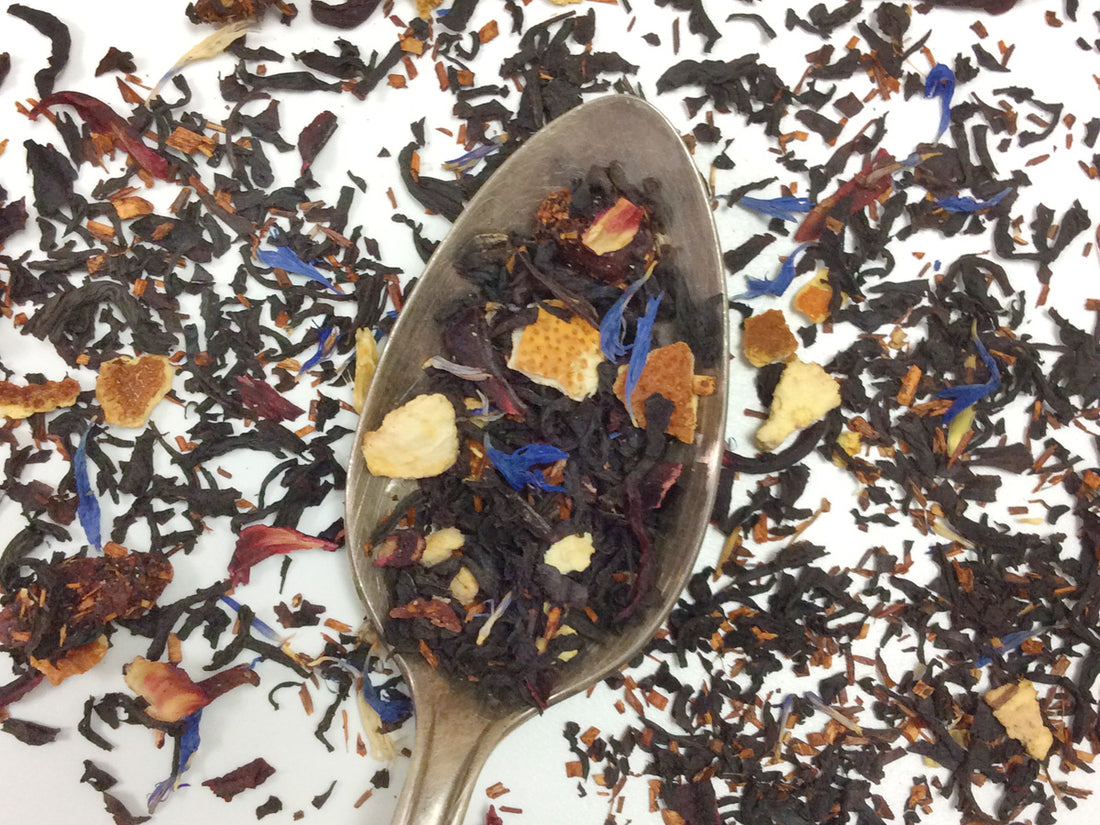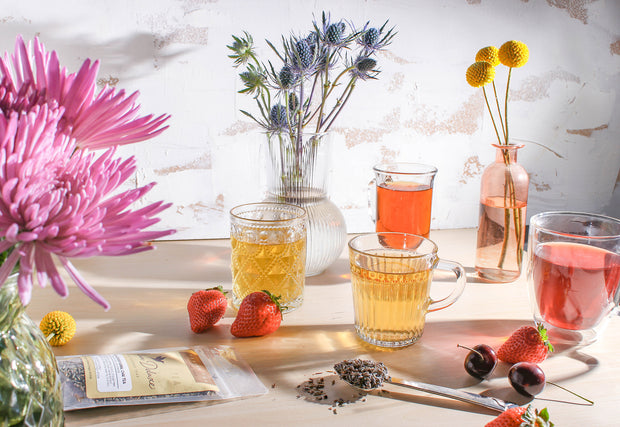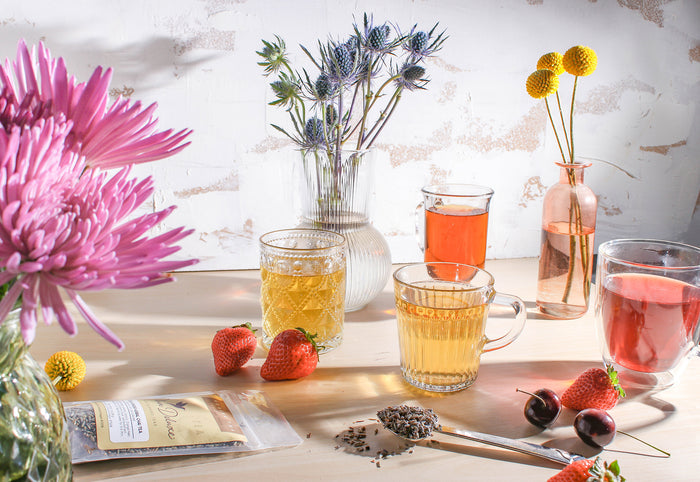So if you’re curious about how your favorite cup of tea is made from start to finish, keep reading! We’ll cover where tea comes from, how it’s made, and give you an inside look at how the blend is finished at Plum Deluxe.

Where Does Tea Come From?
With so many different types of tea leaves, it certainly seems like different teas would come from different plants. But, with the exception of herbal teas, all tea comes from the Camellia sinensis plant. The differences you see between black, oolong, green, yellow, white, and pu’erh tea is all in the variety of Camellia sinensis and the way it’s processed.
Camellia sinensis is only grown in a few places – primarily China, India, Japan, Sri Lanka, and Kenya. The tea leaves used in Plum Deluxe blends come from all of these places, depending on the type of tea needed.
Other ingredients used in the blends come from many different places. The herbs, flowers, and spices used in the finished blends come from all over the world – even right here in Oregon! And while there’s not quite enough room to grow all of the additional ingredients at our HQ, they have been grown and foraged for test blends on occasion.
Andy Hayes, Plum Deluxe's founder and creator, personally oversees tea sourcing and looks for two important things in the companies chosen: tea quality and grower integrity. Plum Deluxe tea blends are known for their delightful aromas and lovely flavors, so the quality and consistency of the tea leaves is a must. The second is just as important: the company’s integrity. It’s crucial to have a first-hand relationship with tea sources in order to verify things like quality control, fair trade verification, and more.

How Is Tea Made?
In this section, we’re covering the “processing” part of tea-making, which happens before the tea reaches Plum Deluxe to be made into a blend. This happens on-site before the tea is shipped by boat to avoid things like mold and rot that would otherwise occur during storage and shipping.
Harvesting and Sorting
Tea leaves are harvested from the top of the plant and only a few times a year. Plucking tea leaves is often done entirely by hand, twice a year: early spring and early summer. There are occasional autumn or winter harvests, but these are far less common.
The tea is inspected for quality, then sorted based on size and appearance. Tea leaves are classified both by variety and how they were harvested. They’re sorted into groups based on how they’ll be processed in the next step, which decides whether they’ll be used for black, oolong, green, or other types of tea.
This is why loose leaf tea is often better quality; tea companies choose what grade of tea they’re buying. So when you get a blend from Plum Deluxe, you’re not getting the tea bag “dust” that you get in mass-manufactured teas.
Withering, Tumbling, and Oxidizing
This is the part of the process that decides what kind of tea will be made out of the leaves.
After harvesting and sorting, the tea leaves are allowed to wither in order to draw out excess water. How long tea takes to wither largely depends on the climate and how leaves are withered. There are a few different methods, which range from 4 hours in perfect conditions with heated air to about 24 hours without help from heat.
The leaves are then tumbled and bruised in bamboo trays or baskets or by kneading and rolling. This helps to speed up the oxidation and can change the way the end result tastes.
The type of tea only depends on how long it’s allowed to oxidize. Green tea isn’t allowed to oxidize at all, keeping its vibrant color and vegetal flavor intact. Oolongs are allowed to oxidize for varying amounts of time, ranging anywhere from 5% to 70% oxidation. You’ll often see different types of oolong: green, light, and dark. The longer it’s exposed, the darker it is. Black teas are allowed to completely oxidize.
Rolling and Drying
Tea leaves, with just a tiny bit of moisture left, are rolled into spirals, pellets, and other shapes. You’ll find many green and oolong tea leaves that are rolled into spheres. If you’ve ever had a gunpowder green or something similar, you know what this looks like! They’re tiny little pellets that unfurl into long, beautiful leaves.
Lastly, the tea is finished by sun-drying, air-drying, or baking. Baking is the most common, but there’s no room for error when it’s done this way. Drying introduces new and unique flavors, especially in green and oolong tea.
Some tea, like pu’erh, isn’t quite done yet! These teas require additional aging and fermentation. It’s hard to get this right, and it's immediately noticeable if the process goes wrong. Pu’erh has a unique taste: sweet, mellow, bitter, and earthy, just to name a few ways people describe it. It truly is a “living” tea with a flavor that develops as it ages.
Finishing Touches
Some tea leaves have a little something extra added during the processing phase, just before they reach Plum Deluxe. Blends like Fireside Chat have been smoked, giving it a unique, smoky-sweet flavor. Hope Blend green tea is infused with jasmine flowers during the drying process.
The rest of the process – creating and finishing tea blends – is done at Plum Deluxe.

Creating Intentional, Carefully Crafted Tea Blends
There’s a lot of creative thinking and testing that goes into creating flavored tea blends. Plum Deluxe is unique in that we sell primarily flavored teas, which is an involved process by itself. It starts with a little inspiration.
“Most often, new recipes are inspired by food: a great-sounding recipe on the Great British Baking Show or something I’ve had at a restaurant recently," says Hayes. "I always have a small notebook with me and record when I have ideas, so there is an extensive list of things for me to work on. If I could just do that all day, I’d love it.”
Blends like Portland Rose City Chai have a bit of local inspiration. This blend was inspired by a gluten free beer made by a local brewer, Ground Breaker.
“When I think about a tea blend, I think about three things, where most companies only thing about the taste: aroma, appearance, and taste," Hayes says. "The majority of what you taste is based on what you smell! So when you see a Plum Deluxe tea, it’s always beautiful and interesting, and I think the aromas of our blends have become somewhat legendary in the industry.”
There’s a careful intention behind every blend. Whether it’s coming up with an evening tea to help you relax and de-stress or an uplifting floral blend to help you get through a rough day, each tea has a specific intention. That same intention is reflected in the naming of each blend, a “magical, special, and very important part of the process.”
The tea goes from an idea to a detailed recipe, which gets made into tiny sample sizes that come in several variations for testing ingredient ratios. Then, the fun part: tasting! Some of these samples get sent to regulars who would be interested in the tea. Or, the Plum Deluxe team takes the samples home to brew and ponder.
After several rounds of tests, a winner emerges! Then come some logistics: labeling, confirming production-scale batches, and making sure all the ingredients are there and ordering what’s missing. Once everything is in order, the blends are assembled and ready to go out.
But not everything sticks around – sometimes a certain ingredient becomes hard to source, or a blend isn’t quite as popular as others. There are only so many blends that can be kept on hand. While Andy loves every blend, it’s only practical to hang on to the very best.
Interested in learning more about tea? Whether you’re looking to learn more about the world of loose leaf tea or bits of history of your favorite blends, there’s tons of awesome information on our blog.

![Spring Break Tea Variety Pack [6-Pack Variety of Flavors]](http://www.plumdeluxe.com/cdn/shop/files/spring-break-pack.jpg?v=1740682266&width=165)















